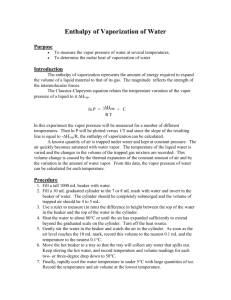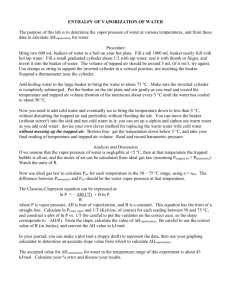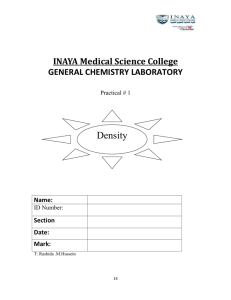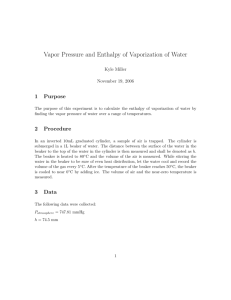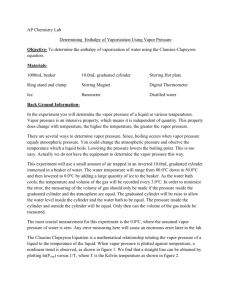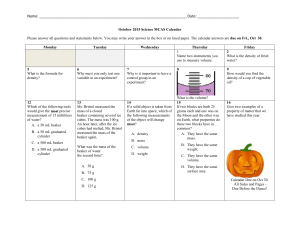Vapor Pressure of Water Lab Report: Clausius-Clapeyron Equation
advertisement
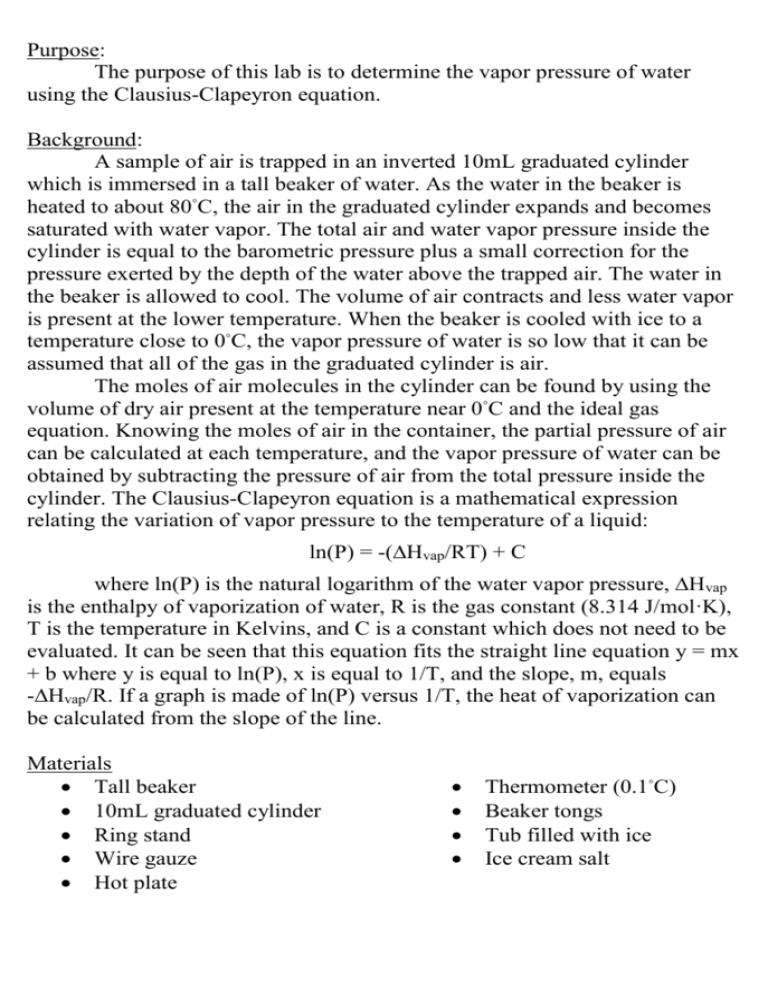
Purpose: The purpose of this lab is to determine the vapor pressure of water using the Clausius-Clapeyron equation. Background: A sample of air is trapped in an inverted 10mL graduated cylinder which is immersed in a tall beaker of water. As the water in the beaker is heated to about 80◦C, the air in the graduated cylinder expands and becomes saturated with water vapor. The total air and water vapor pressure inside the cylinder is equal to the barometric pressure plus a small correction for the pressure exerted by the depth of the water above the trapped air. The water in the beaker is allowed to cool. The volume of air contracts and less water vapor is present at the lower temperature. When the beaker is cooled with ice to a temperature close to 0◦C, the vapor pressure of water is so low that it can be assumed that all of the gas in the graduated cylinder is air. The moles of air molecules in the cylinder can be found by using the volume of dry air present at the temperature near 0◦C and the ideal gas equation. Knowing the moles of air in the container, the partial pressure of air can be calculated at each temperature, and the vapor pressure of water can be obtained by subtracting the pressure of air from the total pressure inside the cylinder. The Clausius-Clapeyron equation is a mathematical expression relating the variation of vapor pressure to the temperature of a liquid: ln(P) = -(∆Hvap/RT) + C where ln(P) is the natural logarithm of the water vapor pressure, ∆Hvap is the enthalpy of vaporization of water, R is the gas constant (8.314 J/mol·K), T is the temperature in Kelvins, and C is a constant which does not need to be evaluated. It can be seen that this equation fits the straight line equation y = mx + b where y is equal to ln(P), x is equal to 1/T, and the slope, m, equals -∆Hvap/R. If a graph is made of ln(P) versus 1/T, the heat of vaporization can be calculated from the slope of the line. Materials Tall beaker 10mL graduated cylinder Ring stand Wire gauze Hot plate Thermometer (0.1◦C) Beaker tongs Tub filled with ice Ice cream salt Safety Precautions: There are no particular hazards in this lab except for the care need in handling the beaker of hot water. Wear chemical splash goggles, and a chemical-resistant apron. Procedure: 1) Record the outside barometric pressure in mmHg at the start of the lab. 2) Fill a 10mL graduated cylinder about 2/3 full of water, close the top with a finger, and quickly invert and lower the graduated cylinder into a tall beaker half filled with water. 3) Add water to the beaker until the water level extends above the cylinder. 4) Use a ruler to measure the difference in height (in mm) between the top of the water in the beaker and the top of the water in the cylinder, h. 5) Heat the beaker to about 80◦C, being sure to continuously stir the water in the beaker to ensure an even distribution of heat. The air trapped inside the graduated cylinder should not expand beyond the scale on the cylinder. If it does, remove the graduated cylinder (using tongs), and start again with a smaller initial volume of air. Record the temperature and the volume of air in the cylinder. 6) Cool the beaker (continue stirring) until the temperature reaches 50◦C, recording the temperature and volume of air in the cylinder every 5◦C. 7) After the temperature of the beaker reaches 50◦C, rapidly cool it to near 0◦C by transporting the beaker to the tub of ice and surrounding the beaker with a mound of ice. Measure and record the volume of air and temperature at this low temperature. Lab Questions: 1) What is vapor pressure and why does it change with temperature? Vapor pressure is the pressure exerted by a liquid’s vapor. As the temperature rises, the kinetic energy of molecules increases, which means that molecules are moving more and more rapidly. Thus, the pressure of the vapor phase increases. 2) What is enthalpy of vaporization? Enthalpy of vaporization is the heat required to cause one mole of a substance to change from the liquid phase to the gas phase. 3) The assumption was made that the vapor pressure of water is negligible at a temperature lose to zero. Find the actual vapor pressure of water at your low temperature and comment of the validity of the assumption. The vapor pressure of water at 7.8C was 7.7 mmHg. This is a small percentage of most of the values recorded, so the assumption is valid. 4) The assumption was also made that the slight changes in “h,” the depth under the surface of the water, will not significantly change the total pressure in the graduated cylinder. Comment on the validity of this assumption. It requires a depth of 13.6 mm of water to change the pressure of the gas by 1 mmHg. Since the atmospheric pressure was 763 mmHg, the relative effect on the atmospheric pressure is extremely small. 5) Were your data values close to a straight line graph? The values were close to a straight line, linear regression. 6) Write out the long “two-point” form of the Clausis-Clapeyron equation. Why does the graphical method of analysis give a better value for the enthalpy of vaporization than does this form of the equation using two temperature-vapor pressure values? lnP = (-Hvap / (RT)) + C The graphical analysis averages a larger number of values, thus resulting in a more accurate answer. Conclusion: The vapor pressure of water at temperatures between 50C and 80C ranges from 74.626 mmHg to 412.89 mmHg, respectively. By using the ClausiusClapeyron equation and a graphical analysis of the data, the natural log of the water pressure and the reciprocal of the temperature of the water are found, and can then be used to calculate the enthalpy of vaporization of the water. A graph of the logarithm of vapor pressures versus the reciprocal of absolute temperature allows the calculation of the enthalpy of vaporization, or Hvap of H2O. Sources of Error As was mentioned above, some error was due to the assumptions made, which amounted to less than a percent for 0mmHg as the partial pressure at 0_C (which could compound and be more or less of an error later on, though) and an unknown amount for letting h be constant. Another source of error was that we did not use distilled water for the experiment. The dissolved ions would have lowered the measured partial pressure of the water. For the calculations, a (hopefully) small error could have arisen due to rounding after every step to 3 or 4 significant figures (depending on the numbers in the equations). Finally, Steven could have been a source of error because he kept taking a little water out of the beaker to boil on the hot plate. This would change the pressure the water exerts on the air and could skew the volume measurements. Observations: The higher the temperature of the water got, the higher the amount of air in the graduated cylinder got. Conversely, the lower the temperature of water, the lower the amount of air in the graduated cylinder. At one point, when the temperature was rather high, the graduated cylinder floated around in the beaker, still maintaining the amount of air in the cylinder.



